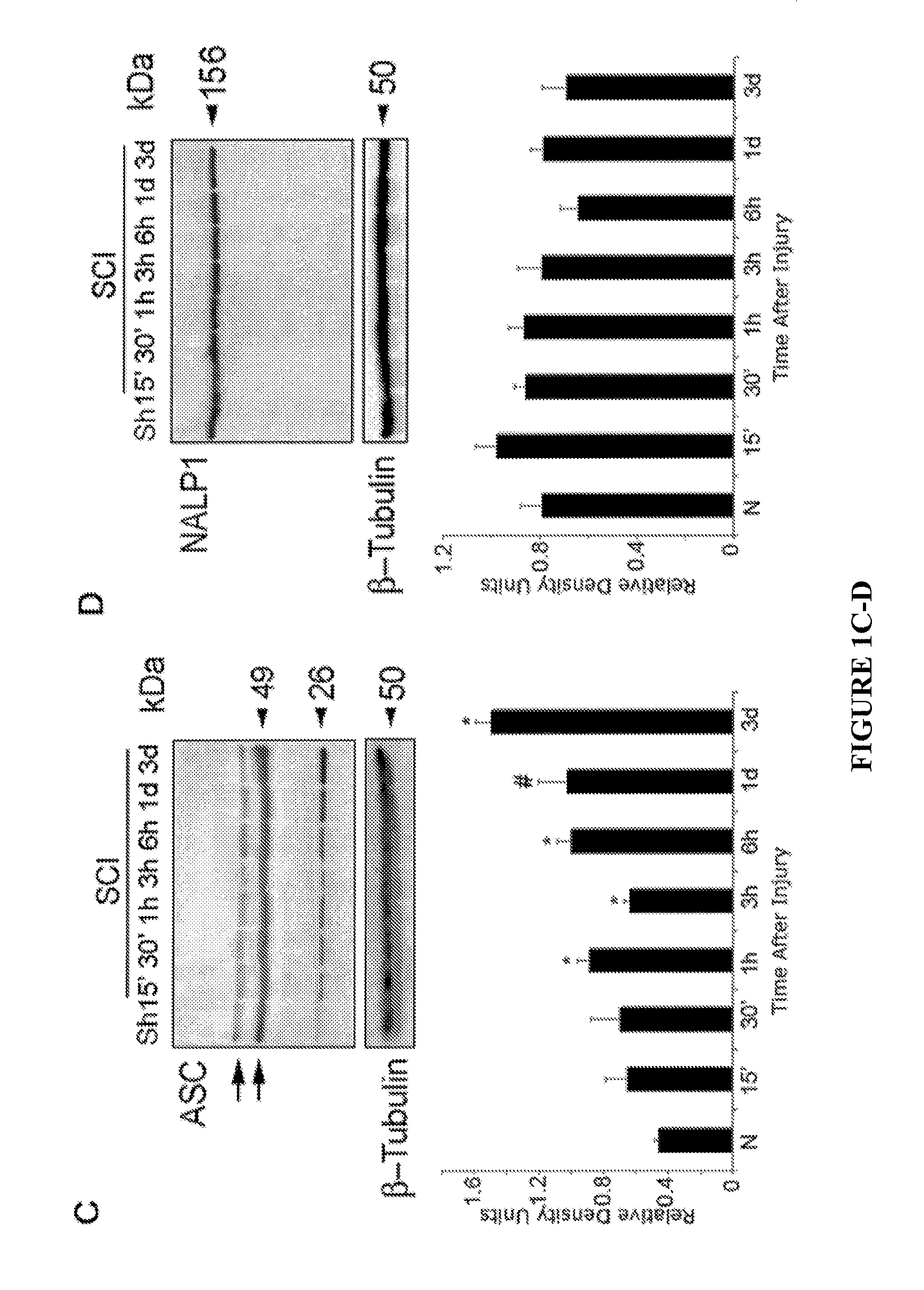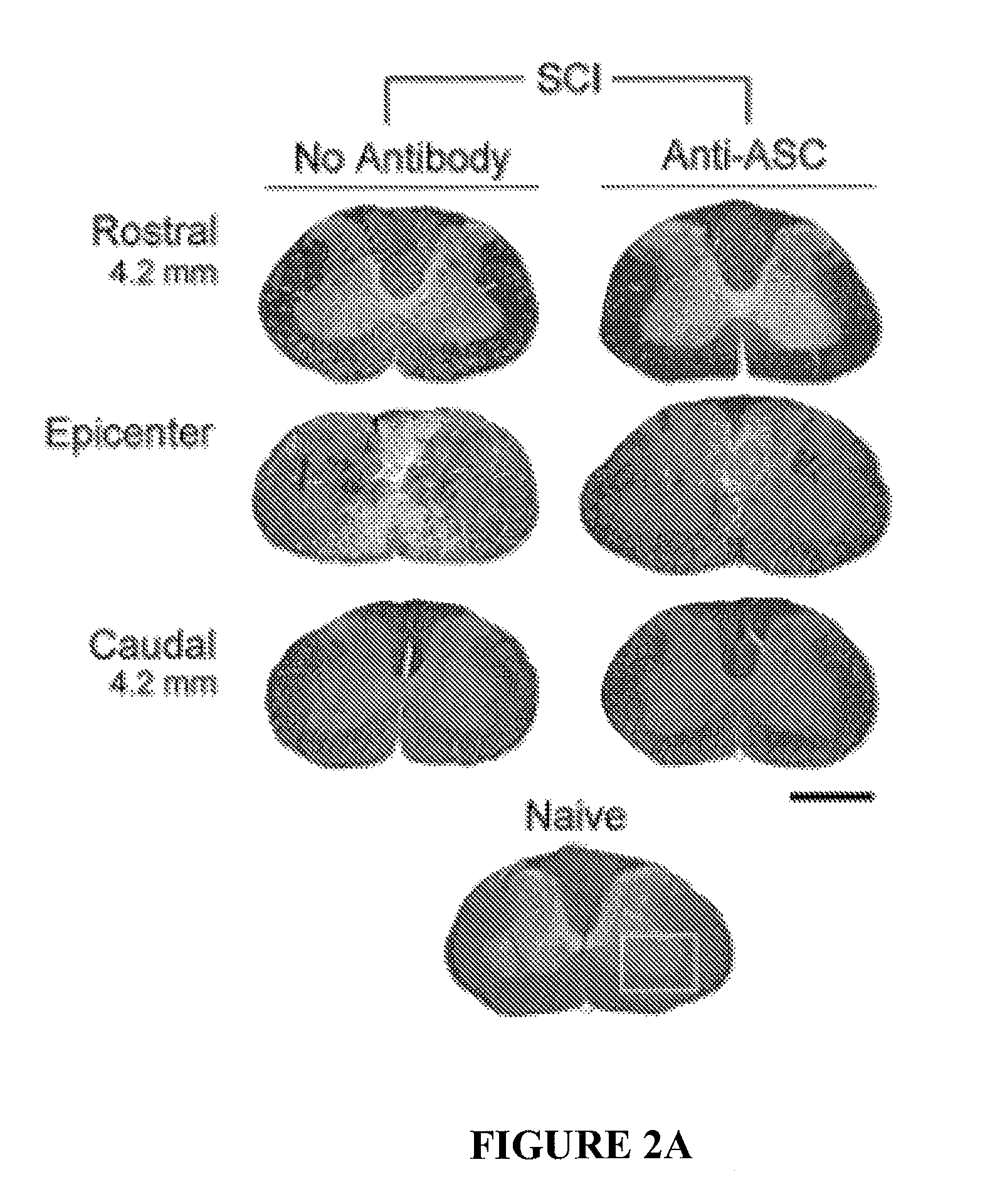Methods of modulating inflammasome activity to treat inflammatory conditions
a technology of inflammasome activity and inflammatory conditions, applied in the field of immunology and medicine, can solve the problems of reducing the productivity of cns injuries, reducing the effectiveness of tbi neuroprotective treatments, and reducing the risk of cns injuries, so as to reduce inflammation, minimize the potential damage of such side effects, and large therapeutic indices
- Summary
- Abstract
- Description
- Claims
- Application Information
AI Technical Summary
Benefits of technology
Problems solved by technology
Method used
Image
Examples
example 1
SCI Activates the NALP1 Inflammasome and ASC Neutralization Improves Histopathological Outcome
[0064]The inflammatory response initiated by SCI involves activation of interleukin-1β (IL-1β) that contributes to secondary cell death. In the peripheral immune response, the inflammasome activates caspase-1 to process proinflammatory cytokines, but the regulation of trauma-induced inflammation in the CNS has not heretofore been clearly understood. In the experiments described herein, it was shown that a molecular platform (termed the NALP1 inflammasome) including caspase-1, −11, ASC and NALP1 is expressed in neurons of the normal rat spinal cord, and forms a protein assembly with the inhibitor of apoptosis family member, XIAP. Moderate cervical contusive SCI induced processing of IL-1β, IL-18, activation of caspase-1, cleavage of XIAP, and promoted assembly of the multiprotein complex. Anti-ASC neutralizing antibodies administered to injured rats entered spinal cord neurons via a mechanis...
example 2
Inhibition of the Inflammasome Complex Reduces the Inflammatory Response after Thromboembolic Stroke in Mice
[0093]The purpose of the experiments described herein was to determine whether the molecular platform NLRP1 (NLR (nucleotide binding, leucine-rich repeat), pyrin domain containing 1), composed of capase-1, ASC (apoptosis-associated speck-like protein containing a caspase-activating recruitment domain) and NLRP1, is expressed in the normal and postischemic brain. Mice underwent thromboembolic stroke to investigate the formation of the inflammasome and subsequent activation of downstream inflammatory responses. Western blot analysis demonstrated expression and activation of interleukin (IL) IL-β and IL-18 at 24 hrs after stroke. Size-exclusion chromatography and co-immunoprecipitation analysis showed protein association between NLRP1, ASC and caspase-1. As early as 24 hrs after ischemia, immunohistochemical analysis revealed inflammasome proteins in neurons, astrocytes, microgli...
example 3
TBI Activates the NLRP1 Inflammasome in Neurons and Anti-ASC Antibody Blocks Inflammation Following TBI
[0114]The results described herein and in provisional application No. 60 / 952,757 filed Jul. 30, 2007, which this application claims priority to are the first reports that the NLRP1 inflammasome is present in spinal cord neurons and plays an important role in the innate CNS inflammatory response after injury (Example 1). This finding indicates that microglial cells, which share properties with tissue macrophages, are not the main source of IL-1β in the brain. Indeed, IL-1β has been implicated in the pathogenesis of several neurological diseases including TBI, Alzheimer's disease, epilepsy, Parkinson's disease and stroke. Given the large number of NLR family members and their distinct but separate expression profiles in tissue, CNS cells may contain a number of yet undiscovered inflammasomes that contribute to a site-specific role in the inflammatory response. The data described here...
PUM
| Property | Measurement | Unit |
|---|---|---|
| temperature | aaaaa | aaaaa |
| diameter | aaaaa | aaaaa |
| length | aaaaa | aaaaa |
Abstract
Description
Claims
Application Information
 Login to View More
Login to View More - R&D
- Intellectual Property
- Life Sciences
- Materials
- Tech Scout
- Unparalleled Data Quality
- Higher Quality Content
- 60% Fewer Hallucinations
Browse by: Latest US Patents, China's latest patents, Technical Efficacy Thesaurus, Application Domain, Technology Topic, Popular Technical Reports.
© 2025 PatSnap. All rights reserved.Legal|Privacy policy|Modern Slavery Act Transparency Statement|Sitemap|About US| Contact US: help@patsnap.com



